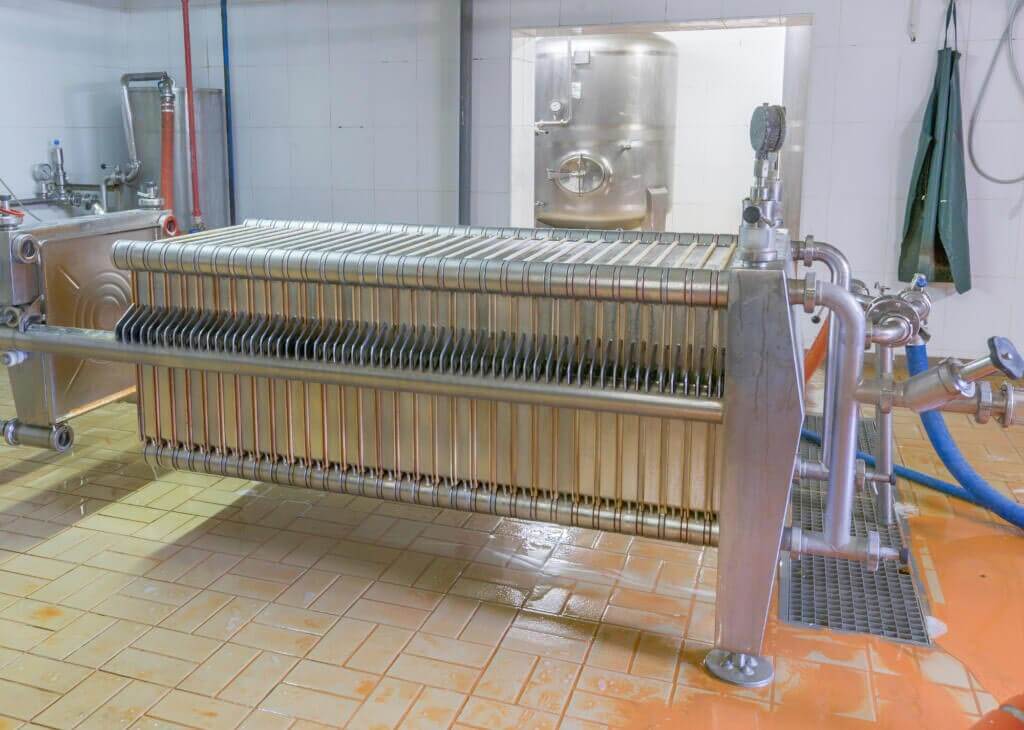Stainless steel plate and frame filter is a commonly used filtration equipment for filtering beer. It mainly has the following characteristics:

Beer filtration is a key link in ensuring beer quality. This article mainly describes several factors that affect the beer filtration effect and specific problems in filtration operations.
Cardboard is also called coated cardboard and supporting cardboard. Its quality is an important factor that determines its usage times and filtration quality. Judging from the use situation, cardboard with a flat surface, consistent thickness, neat edges, and even glue coating has better performance. In addition, cardboard made of a new type of material produced by Penglai has the advantages of high permeability, good adsorption, and no deformation after long-term use. It is very suitable for beer filtration.
Diatomite filter aid is actually a pure amorphous porous silicon with stable chemical properties, no harm to the human body, and no impact on the flavor of beer. In recent years, diatomite resources suitable for the production of food filter aids have been discovered in various parts of our country, and filter aid production plants have been built successively. However, some manufacturers have inappropriate product models and unstable quality, which affects the filtration effect. Practice has proved that only by selecting diatomite filter aids with uniform particle size distribution, strong adsorption and stable technical indicators can high filtration precision and appropriate filtration speed be obtained.
Before beer is filtered, the operation of depositing an effective layer of filter aid on the supporting cardboard is called pre-coating. The purpose of pre-coating is to prevent impurity particles from clogging the cardboard. , and at the same time, satisfactory clarity can be obtained from the beginning of filtration. The greater the amount of pre-coating, the better the depth effect and the higher the clarity of the wine. However, if the amount of pre-coating is too large, it will inevitably affect the total amount of filter aid added, resulting in shortened filtration cycles and a reduction in the total amount of filtered wine. Therefore, it is reasonable to The pre-coating, pre-coating amount and fine soil ratio are very important.
The first layer of pre-coating should use coarse soil to support the second layer and prevent fine soil from entering the deep space of the cardboard. After the circulating water of the first layer is clear, apply the second layer. The second layer of pre-coating uses a coarse and fine mixture of diatomite additives with a thickness ratio of generally (1:1) to form a high-efficiency filtration layer to effectively intercept suspended particles and colloidal impurities.
The thickness of the pre-coat is generally about 20 minutes. The flow rate during pre-coating should not be too fast to avoid causing bubbles and making the coating uneven. After pre-coating, clean water can be used to continue refluxing for 5-10 minutes to make the coating more firmly adsorbed and help extend the filtration cycle.
During the process of filtering wine, the operation of adding diatomite additives to the wine to be filtered evenly and continuously in a certain proportion according to the concentration and properties of suspended particles and colloidal impurities contained in the wine to be filtered is called adding additives. Its function is to make the filter aid particles, ketone substances and impurity particles form a mixed filter, thereby reducing the compressibility of the filter cake. In addition, the ever-expanding “bridging” structure can increase the voids of the filter cake and also play a role in the function of continuously updating the filter bed keeps filtration fast and stable, which ultimately improves filtration efficiency and cycle filtration capacity.
The addition of filter aids must be appropriate to ensure both high filtration precision and appropriate filtration speed. If the added amount is too large, the frame will be filled prematurely, resulting in a shortened filtration cycle and a reduction in the total filtration volume. If the added amount is insufficient, the resistance will increase and the pressure will rise rapidly, resulting in a reduction in overcooking efficiency and even affecting the use of cardboard. life.
Therefore, the proportion and quantity of additives must be adjusted at any time according to the concentration of impurity particles in the wine. Only in this way can the filtration accuracy be ensured, the filtration cycle be extended, the total filtration volume be increased, and the number of times the cardboard is used.
In short, the effect of using a plate and frame diatomite filter to filter beer is satisfactory. The filtered beer fully meets the requirements of hygienic standards for fermented wine, and has the advantages of good clarity and long shelf life.